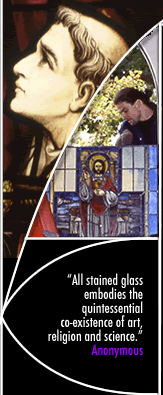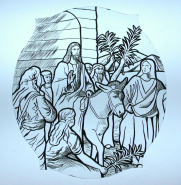


 |
|
Brief History of Stained Glass
Colored glass was used in windows of Christian churches as early as the 5th century, and pictorial glass as early as the 10th century. Although glass was made by Egyptians in 4000 BC, Romans were the first to blow it into pieces large enough to accommodate a window. The twelfth and thirteenth centuries are considered the Golden Age of stained glass. This was an era when most people could not read. Many stained glass windows were designed to depict Gospel stories for the purpose of education and inspiration. Today, the techniques used to produce stained glass windows are much the same as in the Middle Ages. Windows starting with designs and color renderings which take into account the the over all concept of the project, architecture and interior decoration of the building, the shape and size of the windows, the ideas of the client and architect, and a careful research of the history of the subject to be presented. After approval of the design and verifying measurements, a full-scale drawing
is made containing all of the details, but no color. This master drawing, or "cartoon," shows
the exact size and shape of each piece of glass, where the leads in the window
will be and the position of the reinforcing bars. This guides the glass artist
in working with the hundreds or even thousand of pieces of colored glass that
may be involved. The selection of glass to be used is made and approved before any glass cutting begins, but selecting glass is not that simple. The panes of glass, from which these pieces are cut, vary in color, shading, texture, thickness, price and pattern. Consequently the glass artist has to choose sections from the colored glass pane that exactly match the color in the design and best meets the light and shade requirements shown in the color drawing. The aim is to let the glass do the work; the painters add details that glass cannot convey. Two "cut line" drawings are made of the cartoon and each outlined glass piece is numbered. These drawings are used to create paper patterns of each piece of glass and an assembly copy as a guide for the artisan who puts the glass pieces into position. If the window will contain images and or patterns, they are then painted on the glass with special glass paints. The glass is fired in a kiln to permanently fuse the paint to the glass. For many effects several layers of painting and accompanying firings may be required. The pieces are placed on the assembly drawing and fitted together with lead "H" channels called "came." The came is then soldered at the joining points. Measurements are continuously made to assure the finished window will be the exact size required. Putty is forced under the came on both sides of the window to make the window water-tight and rigid, and the window is then cleaned. If needed, copper "tie wires" are then soldered on so reinforcing bars can be attached to the window for added strength and support. |

